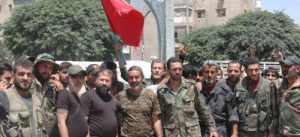Meanwhile, the Assad regime is moving into the final stages of its offensive against the rebellion in Deraa province. Evidence has emerged of the presence of Iran-supported Shia militias among the forces operating on behalf of the regime in Deraa. The two forces whose commanders were photographed in the area are Liwa al-Zulfiqar and the Abu al-Fadl al-Abbas Brigade.
Haidar al-Jubouri, Zulfiqar’s commander, was photographed in the operations room of the Syrian Arab Army’s 4th Division in Deraa. Commanders of the Abu al-Fadl al-Abbas Brigade, meanwhile, were seen in the area of Tafas. Notably, the latter individuals were pictured in Syrian Army uniform and in conversation with Russian officers.
A number of Israeli commentators this week downplayed the significance of these revelations.
They argued that the apparently minor and limited presence of the Shia militias in the Deraa offensive was testimony to the success of Israeli diplomatic efforts to impress upon the Russians the importance of limiting the Iranian presence in the offensives in southwestern Syria.
The Israeli concern is not primarily with Deraa.
Rather, Jerusalem is watching carefully to see which forces will be involved in the regime’s advance on Quneitra province, adjoining the Israeli-controlled part of the Golan.
If the Quneitra offensive involves a mix of forces similar to that in Deraa, this will enable officials to claim that Russian pressure is working, while presumably restating Israel’s determination to continue efforts to expel Iran from Syria in its entirety.
Defense Minister Avigdor Lieberman said this week that “the fact Iranian forces are present in Syria at all is unacceptable, and we will act against any Iranian consolidation in the area.” Prime Minister Benjamin Netanyahu, meanwhile, met this week with Russian President Vladimir Putin. Prior to the meeting, the Prime Minister’s Office issued a statement reiterating that “Israel will not tolerate a military presence by Iran or its proxies anywhere in Syria and that Syria must strictly abide by the 1974 Separation of Forces Agreement.”
So Israel makes clear its determination that Iran should quit Syria in its entirety, acts against specific Iranian targets, and appears to ignore or downplay those elements of the Iranian presence against which air action would have more limited or problematic application (such as pro-Iranian units integrated into the Syrian Army).
The Iranians, meanwhile, appear at present to be absorbing the blows with little apparent attempt at response, while maintaining their overall presence in Syria.
Where may all this be headed? First of all, it is important to understand the nature and dimensions of the Iranian project in Syria.
Iran’s deep alliance with Assad’s Syria goes back to the first days of the Islamic Republic of Iran, and to Hafez Assad’s support of Tehran in the Iran-Iraq War. Over the past seven years of civil war, however, the nature of the relationship has changed. Iranian provision of manpower and organization of paramilitary forces have been essential to the regime’s survival.
Tehran has invested upward of $30 billion in Syria. The Islamic Revolutionary Guard Corps has also recruited young Syrians into locally based IRGC-associated paramilitary groups (Quwaat al-Ridha, 313 battalion) and, of course, brought its paramilitary proxies onto Syrian soil, along with IRGC personnel.
This is a major, far-reaching process, resembling in its key particulars parallel projects in Lebanon and Iraq. The intention is to establish political-military structures that will serve to enable the projection of Iranian power over the long term. The Iranian expertise in this area is without parallel in the region. As a result of this approach, Tehran now dominates Lebanon and has the upper hand in Iraq. Assad’s Syria, which has an openly dictatorial system, is a different political context, of course, but the evidence suggests that the Iranians are digging in to stay.
Will the Russians act as the lever for the removal of this Iranian project? This appears to be the hope of Israeli policy-makers. But the facts would appear to indicate that Russia has neither the will, nor even the ability, to achieve this objective.
Regarding the former, on July 4, Russian Foreign Minister Sergei Lavrov described US and Israeli demands for a complete Iranian withdrawal as “completely unrealistic.”
The Iranian pro-regime media is full of fear and speculation at the prospect of Russian betrayal. The Russian agenda in Syria does not directly parallel that of the Iranians (Moscow seeks good relations with all interested parties, the better to make itself the essential arbiter). But Moscow also has no interest in seeing the Iranians humiliated or their project reversed, particularly because they remain essential to the viability of Assad’s regime.
In any case, the Russian intervention in Syria has been predicated on a modest ground presence.
It is thus not clear by which mechanism Russia could seek to induce such a withdrawal, even if it wished to.
So the Iranian project in Syria is likely to continue, and Iranian- associated forces in one guise or another are likely in the period ahead to be operating close to the border with Israel. Israel, meanwhile, is likely to maintain its intelligence domination across Syria, and to continue periodically to strike at Iranian and Iranian-associated targets, in order to build deterrence and prevent the consolidation of weapons systems and deployments.
Does this sound familiar? It ought to. It is in its essentials the situation that pertains in south Lebanon and (in a far less threatening way) the Gaza Strip.
What we see here is a contest between two systems with entirely different areas of expertise. The Iranians excel in establishing and utilizing political and paramilitary clients to build power within regional spaces. They are, however, sharply deficient in conventional military skills. Israel, meanwhile, is outstanding in the fields of air warfare and intelligence, and seeks to avoid being sucked into involvement in the complex and cutthroat world of proxy warfare within Arab societies (the now soon-to-beabandoned cooperation with the rebels of Quneitra represented only a partial exception to this rule).
The likely emergent picture in Syria, as in Lebanon, is therefore the ongoing consolidation of another IRGC project, in the framework of a weakened and truncated Arab state, along with an ongoing Israeli effort to deter the masters of this project from acts of aggression, or to confine such acts to the realm of rhetoric.
Such a state of affairs is, by its nature, precarious and potentially combustible. At the same time, the Israeli system has shown considerable skill in recent years precisely in the management of comparable situations.
Jonathan Spyer is a fellow at the Middle East Forum and a research associate at the Jerusalem Center for Strategic Studies.
https://www.meforum.org/articles/2018/is-southern-syria-heading-for-lebanonization?utm_source=Middle+East+Forum&utm_campaign=dde5bbb461-SPYER_CAMPAIGN_2018_07_18_02_36&utm_medium=email&utm_term=0_086cfd423c-dde5bbb461-33670769&goal=0_086cfd423c-dde5bbb461-33670769



 JONATHAN SPYER
JONATHAN SPYER 